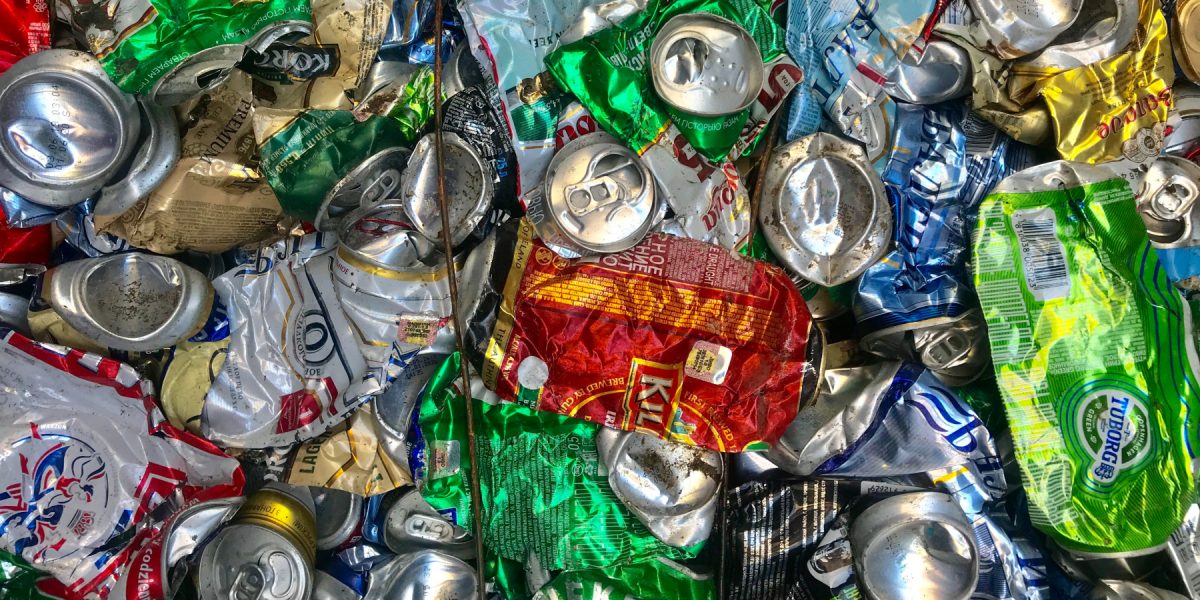Aluminum

Aluminum Recycling
Aluminium has an extremely high recycling rate globally because there is a high value for the material, it can be nearly infinitely recycled and global infrastructure for aluminium recycling is widely available. Aluminum is a great example of a material that is high in value, lightweight to transport, and has high capability and likelihood of being recycled. However, aluminum is only a sustainable solution if it is effectively recycled.
The Cost of Aluminum
The production of virgin aluminum has a steep social and environmental cost. Aluminum is created from the processing of raw bauxite ore. While bauxite is one of the most commonly found minerals across the planet, mining and harvesting bauxite is resource-intensive, highly polluting, and a very dangerous process that threatens the health of communities disproportionately located in low-income communities and developing countries.
Bauxite is harvested through a process called strip mining also known as open-pit mining, which includes excavating large areas of earth close to the surface to reveal raw bauxite that is then transported to smelters where aluminum oxide is produced. This large-scale land excavation causes habitat destruction, removal of top soil and native vegetation, as well as intense erosion. The smelting process is highly energy and water intensive and is commonly fueled by coal and other fossil fuels that release greenhouse gas emissions. Harmful emissions include carbon dioxide and perfluorocarbons as well as other harmful air pollutants like sulfur dioxide and fluorides (UNCTAD).
Bauxite mining primarily takes place in Australia, China, Africa, India, and Latin America (NS Energy). As an example, communities in Guinea, Jamaica, and Malaysia where bauxite is a primary export, suffer from loss of ancestral land, pollution and depletion of drinking water, and health concerns. Additionally, their livelihoods and mobility justice are threatened from the significant amount of dust produced through mining operations (Human Rights Watch, Columbia Climate School, Jamaica Observer, Taylor & Francis, Research Gate). Research indicates that communities living near bauxite mining areas experience social and psychosocial impacts from soil and water pollution, deforestation, noise pollution, destruction of public infrastructure, erosion, and respiratory and skin problems from dust and particulate matter (including PM2.5) pollution (IJPHCS, NCBI).
Facts:
Recycling a single aluminum can save enough energy to power a TV for two hours or a computer for three hours. (EPA)
The average person has the opportunity to recycle more than 25,000 cans in a lifetime. (Recycle Across America)
The Container Recycling Institute (CRI) estimates that the 36 billion aluminium cans landfilled last year in the USA had a scrap value of more than $600 million.
Summary
The good news is that recycling aluminum reduces all negative environmental and social consequences of virgin production. Producing recycled aluminum only requires 5% the energy of virgin production (EPA). In addition, recycling aluminum can save money on disposal costs, and reduce the negative impact of burying aluminum in landfills or burning aluminum in incinerators. The U.S. Aluminum Association self-reports that nearly 75% of all aluminum ever produced in the U.S. is still in circulation. It is possible to keep aluminum infinitely in circulation with proper collection and infrastructure availability.
Tips:
Remember to recycle aluminum cans and bottles ~ aluminum is only a sustainable choice if recycled.
Wash your aluminum foil and be sure to recycle that as well!
